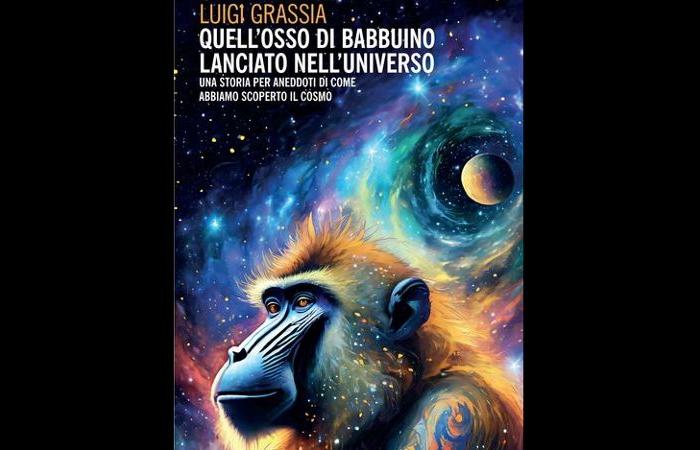We publish an excerpt from the Introduction of the book “That baboon bone launched into the Universe. An anecdotal story of how we discovered the Cosmos”, by Luigi Grassia (Mimesis Edizioni, 2024).
The first astronomer in prehistory was a woman. We don’t know for sure, but it’s likely, because that person of 43 thousand years ago he counted and chipped on a baboon bone 29 notches, one for each day of the lunar phases and the average menstrual cycle, something of female rather than male interest. In the following millennia, many other hands engraved on bones (the findings tell us) the phases of the ascending and waning moon, chipped round or sickle lunettes in a row, counted the lunar and menstrual cycles that each year contains, and underlined the – imaginary – connection – between the Moon and menstruation, painting their astronomical engravings/recordings with red ochre, the color of blood. And it is likely that these hands were also women’s.
https://www.lastampa.it/cultura/2024/03/22/news/quellosso_di_babbuino_lanciato_nellUniverso-14167696/#google_vignette
THE REVELATION OF THE BUSHMANS. But how do we know that that certain baboon bone, dating back to 43 thousand years ago, with 29 notches engraved on it, does not count (for example) 29 antelopes captured, but precisely the days of the lunar phases and the menstrual cycle? We are probing the dawn of human awareness and the scientific approach to the world, and we risk misunderstanding every clue to the past; yet anthropology comes to our aid: in southern Africa, that is, precisely in the region of the world where that ancient chipped bone was found, the current San (otherwise called Bushmen) after 43 thousand years continue to use bone calendars made precisely in that way, to take into account both the phases of the moon and menstruation; and this suggests to us that an uninterrupted thread, which has never been broken, connects the very remote past with our present, carrying with it a load of meanings.
STANLEY KUBRICK’S FILM. It really went like in the movie “2001: A Space Odyssey”: there, on the crest of the transformation from pre-man to man, an ape throws a bone into the air, and in its flight the bone condenses all of human evolution, until it transforms into a space station. In the reality of history, a small bone engraved with the days of the lunar phases started the progressive exploration of the heavens and the investigation of the laws that regulate them, gradually making us discover the nature of the solar system, the galaxies, the Universe and ( final frontier, still in doubt) of multiple Universes. The difference between fiction and reality is that “2001” imagined that the spark of human awareness was sparked by hunting, war and male activities, while paleontology and anthropology suggest (they don’t prove, but suggest) that the female contribution was equally or perhaps more important.
THE BIG BANG OF INTELLIGENCE. Human beings have within themselves the cognitive potential for discovery and conscious exploration, within certain limits. But why did that potential, which was present in all the most intelligent apes, develop out of all proportion only in homo sapiens, while it was content with much more modest achievements in the other anthropomorphic apes? It is a colossal question, perhaps destined to never have a certain answer. Yet paleoanthropology is able to venture, with prudence, a precise and unambiguous answer: the Big Bang of human intelligence, as distinct from ape intelligence, could be due to a miraculous event 3 million years ago, that is, to the ingenious invention of one of our australopithecine ancestor (again: a female individual) who solved a fundamental problem of survival for us and made a boom in the size of our brain possible. In studying chimpanzees, the ethologist and anthropologist Jane Goodall verified that in the first two months after birth 50% of puppies die for a trivial cause: they are unable to hold on to their mother while she moves. But human newborns are even clumsier: the percentage of those who don’t know how to hold on is 100%. How is it possible then that our species survived when it lived in the ape state?
INVENTING THE NEWBORN WRAP. According to two other scholars, Cara Wall-Scheffer and Timothy Taylor3 million years ago an australopithecus solved the problem by inventing the baby sling. It was a simple leaf with a knot to tie the baby to the mother’s chest. This is part of the cognitive abilities of monkeys, even those less evolved than chimpanzees: in nature they know how to tie knots, they use them to build nests of leaves and branches, but none before the australopithecus (our pre-human ape-like ancestor) , had you ever thought of using leaves and knots for a baby sling. The moment of the stroke of genius arrived, and has been there ever since a steady increase in brain size in the australopitecus-herectus-sapiens evolutionary line: it became possible to give birth to children who were not yet fully developed and unable to support themselves, as the band supported them so much. Thanks to the newborn sling, human children, unlike baby monkeys, who have to get by right from the start, have the possibility of being born and surviving as immatures, with the bones of the skull not yet fused, and can complete, as they do, the brain development for seven months after birth, at the rate of a billion new synapses per minute. A 9 + 7 month gestation would not be possible inside the uterus, because in 16 months the size of the brain and body of the fetus would grow to the point of becoming incompatible with that of the mother’s body. Almost incredible to say, it seems that it was the simple invention of the baby sling (a leaf with a knot) that allowed us, and only us, the very long evolutionary transformation from monkeys with a four-ounce brain to human beings with brains of a kilo and a half. A brain capable of feeling curiosity, of exploring the environment with different and more sophisticated motivations than the simple immediate search for food and sex, of asking questions about the sky and the Earth and of risking answers, of making rudimentary astronomical observations and of impacting them on an animal bone, and (eventually) also to make orbital telescopes.
DARWINIAN EVOLUTION. If anyone ever doubted the very close relationship between biological evolution and the development of physical science and astronomy, let us quote an Italian theoretical physicist, the Einstein Prize Tullio Reggewhich thus unites the two themes: “Human beings are a product of Darwinian evolution. His mental structure and logical categories were influenced by the struggle for survival in the nature in which he evolved on the African savannah. We intuitively know those natural laws and mathematical rules that allow us to survive. This basic approach imposes on us a substantially anthropomorphic vision of the world around us”, including stars, galaxies and the Universe. It is not a fact without consequences: given that our brain did not evolve to discover the mysteries of the Cosmos, but (more prosaically) to help us survive in the African savannah, Our 100 billion brain cells are not necessarily capable of understanding how the Universe works, either now or in the future.; our brain may take us down that road up to a certain point, but no further. Something could remain inaccessible forever.





